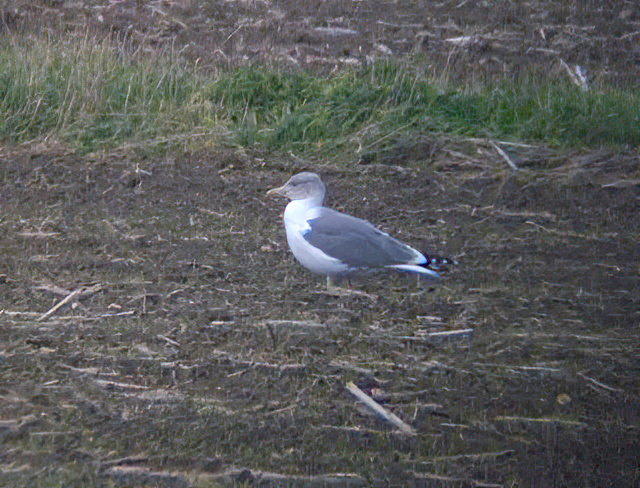Azorean Yellow-legged Gull Larus michahellis atlantis

| Site | First date | Last date | Count | Notes |
| Marston | 26/10/2015 | 1 | Adult, 10CY+ |
Finder's report: Azorean Yellow-legged Gull Larus michahellis atlantis at Marston, October 26th 2015: first county record
by Ben Ward and Dave Roberts.
On the early morning of October 26th, Dave Roberts and I were at Marston. The previous evening, we had encountered a vast finch flock on the surrounding bare fields just before dusk, and we hoped to be able to properly look through them in better light. The fields that the finch flock had frequented were quiet on arrival though distantly we noticed that there was a relatively small flock of large white-headed gulls on a bare field to the east. They looked predominantly to be Lesser Black-backed Gulls Larus fuscus but there was a handful of paler mantled birds amongst them. We moved closer to their location in the car, to what seemed to be the best viewpoint, still a fair distance of several hundred yards away. I crept out from the shielded side to have a cursory look with bins but immediately the flock flushed, flying low to the west and out of sight.
As this is DR’s local patch and knowing the area like the back of his hand, he fancied that he knew where they might have flown to, so we headed to the western side of the area. By 08.10 the flock had been relocated and being as stealthy as was possible we viewed from a farmer’s access point in the field’s hedgerow. The group was made up of approximately 30 individuals, mainly adult birds, the majority being graellsii Lesser Black-backed Gulls as well as three darker mantled intermedius types; the paler mantled birds comprised two argenteus Herring Gulls, one adult Yellow-legged Gull Larus michahellis and a further striking adult ‘Yellow-legged Gull’.
With the ‘scope very quickly set up, there was no doubt about it, this further individual was an extremely interesting-looking bird indeed: fairly small, compact, the mantle looking an unusual and unfamiliar darkish grey, contrasting strongly with the bright white wide tertial crescents and underparts, and the mantle tone appeared intermediate between michahellis and graellsii. Somewhat startling was the striking ‘hooded’ appearance of the bird, the dense head streaking in fact formed a perfect hood, most distinctly concentrated around the eye with no further streaking on the neck or breast. Bare parts appeared in keeping with the bird’s smallish jizz, the bill not overly long and the legs on the short side, both being a strong but not bright yellow. Alarmingly this bird certainly was far removed from any nominate adult michahellis I had seen previously.
Just as I started to obtain some digiscoped images the flock appeared to spook and got up, flying high and purposefully towards the Nottinghamshire border. We watched them until eventually they were so distant that they were completely lost to view. At that moment, almost in jest, I said to DR “Better send the photos to Dean Nicholson later to rule atlantis out”.
I reasoned that this could be Larus michahellis at the most extreme end of the spectrum regarding mantle tone and head streaking knowing that equally, perhaps more plausibly, a hybrid was a possibility. L.m. atlantis was well on the radar, but surely was not considered a possibility as at the time it was considered a near mythical vagrant. Immediately upon arriving home I uploaded the images and sent them to Larid aficionado DN. His swift response left me speechless; the first two words of reply were “Wow, atlantis?”. The images were circulated for comment.
A couple of days passed by and then to my amazement on October 29th, DN got in touch with the news that he had found the bird at Kilvington Lakes 5.8 miles away in Nottinghamshire. DN, having studied the bird himself, was now convinced that it was indeed the real deal. It seemed a further twist of fate that DN had invited Colin Scott along, as he is an aspiring bird photographer. Whilst DN scrutinised the bird CS was poised with his camera and flight photographs were obtained. Subsequent comment on the bird was overwhelmingly positive. Feedback from the late great Martin sticks in my mind and will never be forgotten. He described it as “the kind of bird I want to find!”.
The Lincolnshire bird is considered to be the bird found in Oxfordshire in October 2009, which has subsequently been seen at various localities around the Midlands. The subspecies is mooted as a potential split from nominate Yellow-legged Gull as work on the taxon continues. Azorean Yellow-legged Gull breeds on the Azores but birds showing similar morphology also breed on the Canary Islands and Madeira.
This record was accepted by BBRC (British Birds 109(10): 566-631) and Azorean Gull was duly admitted to the British List by in May 2016 by virtue of a long-staying 2CY bird in Cornwall in 2008.
Reference
Stoddart, A. and McInerney, C (2017). The ‘Azorean Yellowlegged Gull’ in Britain. British Birds 110: 666-674.
Ward, B. and Roberts, D. (2015). Azorean Yellow-legged Gull Larus michahellis atlantis: first record for Lincolnshire at Marston, 26th October 2015. Lincolnshire Bird Report 2015:179-180.

